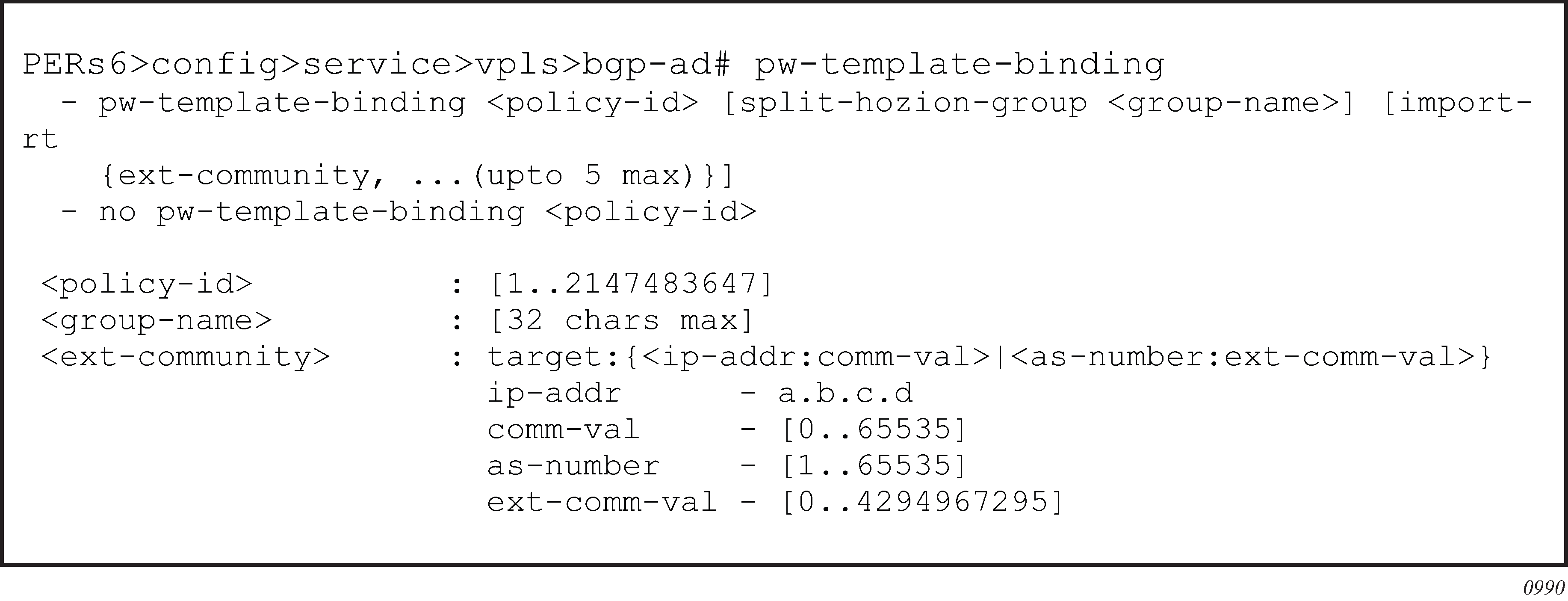The pseudowire template is defined under the top-level service command (config>service>pw-template) and specifies whether to use an automatically generated SDP or manually configured SDP. It also provides the set of parameters required for establishing the pseudowire (SDP binding) as follows:
PERs6>config>service# pw-template 1 create
-[no] pw-template <policy-id> [use-provisioned-sdp | prefer-provisioned-sdp]
<policy-id> : [1..2147483647]
<use-provisioned-s*> : keyword
<prefer-provisioned*> : keyword
[no] accounting-pol* - Configure accounting-policy to be used
[no] auto-learn-mac* - Enable/Disable automatic update of MAC protect list
[no] block-on-peer-* - Enable/Disable block traffic on peer fault
[no] collect-stats - Enable/disable statistics collection
[no] control word - Enable/Disable the use of Control Word
[no] disable-aging - Enable/disable aging of MAC addresses
[no] disable-learni* - Enable/disable learning of new MAC addresses
[no] discard-unknow* - Enable/disable discarding of frames with unknown source
MAC address
egress + Spoke SDP binding egress configuration
[no] force-qinq-vc-* - Forces qinq-vc-type forwarding in the data-path
[no] force-vlan-vc-* - Forces vlan-vc-type forwarding in the data-path
[no] hash-label - Enable/disable use of hash-label
igmp-snooping + Configure IGMP snooping parameters
in gr ess + Spoke SDP binding ingress configuration
[no] l2pt-terminati* - Configure L2PT termination on this spoke SDP
[no] limit-mac-move - Configure mac move
[no] mac-pinning - Enable/disable MAC address pinning on this spoke SDP
[no] max-nbr-mac-ad* - Configure the maximum number of MAC entries in the FDB
from this SDP
[no] restrict-prote* - Enable/disable protected src MAC restriction
[no] sdp-exclude - Configure excluded SDP group
[no] sdp-include - Configure included SDP group
[no] split-horizon-* + Configure a split horizon group
stp + Configure STP parameters
vc-type - Configure VC type
[no] vlan-vc-tag - Configure VLAN VC tag
A pw-template-binding command configured within the VPLS service under the bgp-ad sub-command is a pointer to the pw-template that should be used. If a VPLS service does not specify an import-rt list, then that binding applies to all route targets accepted by that VPLS. The pw-template-bind command can select a different template on a per import-rt basis. It is also possible to specify specific pw-templates for some route targets with a VPLS service and use the single pw-template-binding command to address all unspecified but accepted imported targets.

It is important to understand the significance of the split horizon group used by the pw-template. Traditionally, when a VPLS instance was manually created using mesh-SDP bindings, these were automatically placed in a common split horizon group to prevent forwarding between the pseudowire in the VPLS instances. This prevents loops that would have otherwise occurred in the Layer 2 service. When automatically discovering VPLS service using BGP AD, the service provider has the option of associating the auto-discovered pseudowire with a split horizon group to control the forwarding between pseudowires.